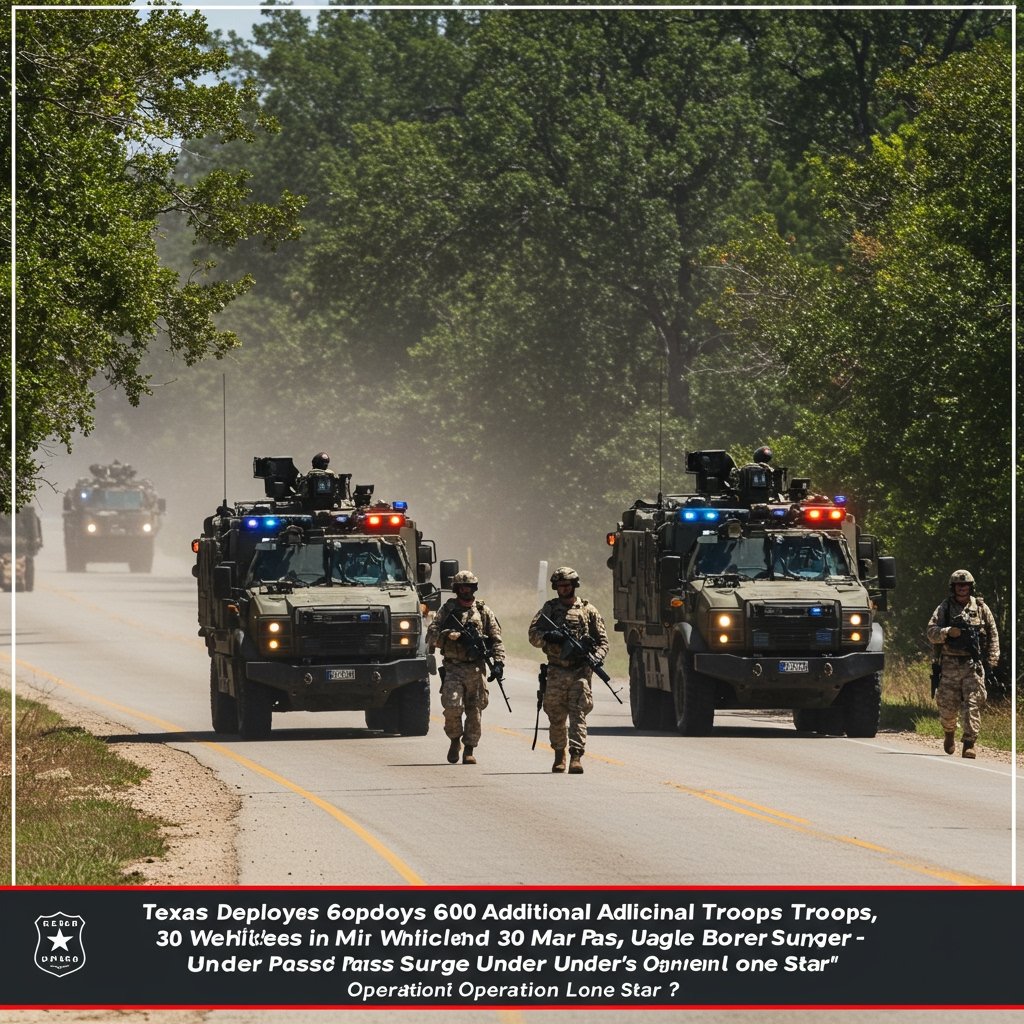Texas Boosts Border Operations with Significant Troop and Vehicle Surge in Eagle Pass
EAGLE PASS, Texas – The State of Texas today announced a substantial reinforcement of personnel and assets directed towards the Eagle Pass sector of the U.S.-Mexico border. This strategic deployment, executed under the auspices of Operation Lone Star, represents a significant intensification of state-led border security efforts in a key area frequently impacted by high levels of illegal immigration and transnational criminal activity. Officials from the Texas Department of Public Safety (DPS) and the Texas National Guard confirmed the immediate deployment of an additional 600 troops and 30 tactical vehicles to the region.
Governor Greg Abbott issued a statement detailing the scope of the reinforcement, emphasizing its critical role in bolstering the state’s ongoing initiative. This expansion of resources is effective immediately and is explicitly aimed at enhancing the state’s capacity to interdict illegal crossings and combat cartel activity. The move comes in direct response to what state officials characterized as increased migrant flows observed earlier this month in the Eagle Pass area, highlighting the dynamic and evolving nature of the border security challenge.
Operation Lone Star: State’s Proactive Stance
Operation Lone Star was initially launched by Governor Abbott in March 2021 as a multi-agency effort designed to deter and interdict illegal immigration, drug smuggling, and human trafficking along the Texas border. The operation integrates personnel and resources from the Texas Department of Public Safety and the Texas Military Department (which includes the Texas National Guard), alongside other state and local partners. Its mandate includes deploying law enforcement officers and military personnel to detect and deter illegal activity, apprehend individuals crossing unlawfully, and disrupt the operations of criminal organizations exploiting the border.
The operation has utilized various tactics, including increased ground and air patrols, the construction of state-funded border barriers, and the apprehension of individuals under state laws, such as trespass. It operates on the premise that the state must take proactive measures to secure its border, citing what state officials describe as insufficient enforcement by the federal government.
Eagle Pass Sector: A Critical Focus Area
The Eagle Pass sector of the U.S.-Mexico border, encompassing a portion of the Rio Grande, has historically been one of the busiest corridors for illegal crossings. Its geographical features, including the river and surrounding terrain, as well as its proximity to major transportation routes on both sides of the border, make it a persistent magnet for migrant flows and cartel operations. The sector includes Maverick County, an area that has seen considerable state attention and resource allocation under Operation Lone Star in the past.
Increased activity in this sector often strains local resources and presents complex challenges for law enforcement and border security agencies. The decision to surge resources specifically into the Eagle Pass sector underscores the state’s assessment of current conditions and perceived vulnerabilities in this particular area.
Details of the Deployment
The deployment involves an additional 600 troops from the Texas National Guard and the integration of 30 tactical vehicles. The addition of 600 personnel significantly increases the operational footprint on the ground, allowing for expanded patrol coverage along remote stretches of the border, enhanced surveillance capabilities, and a greater capacity for rapid response to crossing attempts. These troops work in conjunction with Texas DPS troopers and existing National Guard units already assigned to the area.
The 30 tactical vehicles provide increased mobility and operational capacity across diverse terrain. These vehicles are often utilized for transporting personnel to remote locations, conducting mobile patrols, supporting interdiction efforts, and providing logistical support. Their deployment enhances the ability of state forces to cover more ground effectively and respond swiftly to intelligence or observed activity.
Personnel involved in the surge deployment will be tasked with a range of duties consistent with Operation Lone Star’s objectives, including patrolling the border, monitoring surveillance technology, intercepting individuals attempting to cross unlawfully, and coordinating with other law enforcement entities. Their presence is intended to act as a visible deterrent and to actively disrupt illegal cross-border movements.
State Funding and Coordination with Federal Efforts
A key characteristic of Operation Lone Star, and explicitly stated in the context of this surge, is that the operation is funded by state appropriations. This distinguishes it from federal border security operations conducted by agencies like U.S. Customs and Border Protection (CBP) and Immigration and Customs Enforcement (ICE). State funding allows Texas to direct resources and dictate operational priorities independently of federal funding mechanisms.
State officials were clear in their communication that this expansion is intended to supplement federal efforts, not replace them. While Texas operates Operation Lone Star using state resources and under state authority, its personnel often operate in proximity to, and at times coordinate with, federal border security agencies. However, the operational strategies, legal authorities utilized (such as state trespass laws), and funding mechanisms remain distinct.
This clarification about supplementing federal efforts reiterates the state’s position that its actions are aimed at filling perceived gaps in federal enforcement and providing additional layers of security along the border, particularly in areas experiencing heightened activity. The surge is presented as a necessary measure to address immediate challenges posed by increased migrant flows and ongoing cartel operations in the Eagle Pass sector using state-controlled assets and personnel.
Objectives and Outlook
The primary objectives of the increased deployment are twofold: to enhance the capacity to interdict illegal crossings and to more effectively combat cartel activity. By increasing the presence of uniformed personnel and operational vehicles, the state aims to make unlawful crossings more difficult and dangerous for migrants and to disrupt the smuggling networks operated by criminal organizations.
The surge is a direct tactical response to the increased migrant flows observed earlier this month, indicating that the state monitors real-time conditions along the border and adapts its strategy accordingly. The effectiveness of the surge will likely be measured by metrics such as the number of interdictions, arrests under state law, and reported disruptions of smuggling operations within the Eagle Pass sector.
The situation along the border remains dynamic, influenced by various factors including seasonal migration patterns, policy changes, and geopolitical events. The deployment of an additional 600 troops and 30 tactical vehicles represents a significant escalation of the state’s commitment and investment in border security efforts in the Eagle Pass area under Operation Lone Star. This reinforcement underscores Texas’s determination to utilize its own resources to address border security challenges as perceived by state leadership.






